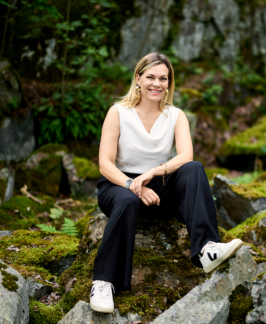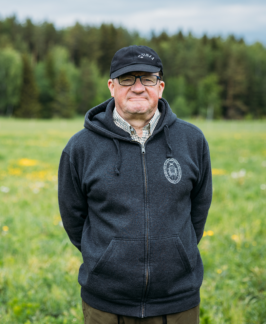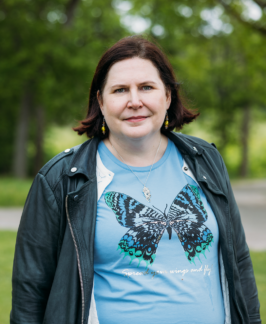Back to Nature —
Decomposing back into nature is a good enough meaning of life for artist Teemu Lehmusruusu.

Saving the Baltic Sea is a long-term effort, but it can be done by working together.
Over the years we have managed to reduce nutrient leaching that causes eutrophication, but much work remains to be done.
Everyone can play a part in saving the Baltic Sea. Get inspired by these articles and the different ways to help our only sea. Find your own way to be a Protector of the Baltic Sea.
My relationship with the Baltic Sea was love at first sight. The sea is the most beautiful thing in the world, and it’s heart-wrenching to see my beloved Baltic Sea suffering.
I work for the Baltic Sea in many different ways, as there’s no single solution to its many problems. My work aims to bring about action that will save the Baltic Sea, preserve biodiversity and fight climate change.
There’s a lot of work to be done, but BSAG’s concrete cooperation with businesses, scientists and policymakers demonstrates that a clean and vibrant Baltic Sea is achievable. We must never give up.


Back to Nature —
Decomposing back into nature is a good enough meaning of life for artist Teemu Lehmusruusu.

Heading to the field at sunrise —
Professor Anna-Liisa Laine thinks that nature’s regulatory mechanisms should be integrated into food production.
Finnish food – and its sustainability – has always been very important to me. I work in Valio’s climate team, helping to ensure that regenerative farming and carbon farming – measures that improve soil health, mitigate climate change and protect the Baltic Sea – can be widely adopted in Finnish agriculture.
These are long-term efforts that will take years to have their full impact, and sometimes your own work feels too insignificant in the face of these enormous issues. But what gives me hope is that we’re doing this together, and so many farms have already introduced these measures. Because it is from small streams that big rivers rise.


A Poem about Farming —
The Hasu family has been cultivating land in the same place since the 1500s.

The Harbour of Love —
Irina Wahlström and Patrik Hellman’s lives are intertwined with the Baltic Sea.
Surprisingly, a large part of our work to save the Baltic Sea happens on land. The soil health of arable land in the sea’s catchment area is directly linked to the volume of nutrients that end up in the water. My work has a concrete impact on this by helping farmers to fix problems in their fields, so that healthy soil can keep water and nutrients in the fields for plants to use – and out of the Baltic Sea.

As a PhD researcher, I aim to find out how climate change will affect nutrient run-off from agriculture and how farmers can consider environmental impacts in their work. It is paramount to expand the use of measures that have been proven to work because together, we can make a decisive difference to the state of the Baltic Sea. I want to take the results of my research to the grassroots so that they do not remain on the shelf gathering dust but can help farmers transition to sustainable agriculture.

As a boater and mother of three children, saving the Baltic Sea is important to me. Through my work at Anora, I can help to support regenerative farming, which will in turn reduce the nutrient runoff from fields into the Baltic Sea. Anora is a major purchaser of Finnish barley, and we want to shoulder our responsibility for our unique common waterways.

Both the current, poor state of the Baltic Sea and hope for its recovery inspired me to take concrete action. As a farmer, I can directly influence the nutrient load that ends up in the Baltic Sea both in my own fields and through cooperation with other farmers and forest owners.

I want to help the environment through scientific research. As head of Carbon Action research activities, I make sure that BSAG’s Baltic Sea conservation work has access to the best possible information about climate change and sustainable methods for managing fields and forests. I find this work meaningful, that is, developing and implementing solutions that will protect both the Baltic Sea and the environment as a whole in collaboration with BSAG and its influential partners.

The Baltic Sea has been a part of my life since I was a child. My concern for it also goes back a long way. Saving the Baltic Sea necessitates major changes, which in turn require information and concrete action.
Although Finland is a small country, we have the expertise and resources to find functional solutions that can be used elsewhere in the world. We are also able to quickly apply lessons from around the world. This is exactly what we are aiming for through BSAG’s activities in general and on our Qvidja pilot farm, which we hope will act as a trailblazer for mainstreaming regenerative agriculture both in Finland and around the world.

Saving the Baltic Sea is my prime objective. It’s my job to ensure that the work we do for the Baltic Sea at BSAG is as effective as possible.
The Baltic Sea’s problems are complex, and finding solutions requires help from a really broad range of parties – from researchers to companies, companies to farmers, and farmers to officials. My work revolves around building and maintaining cooperation between the partners we need to help us save the Baltic Sea.

Baltic Sea nature is important to me. My research aims to understand the processes that maintain biodiversity in agricultural environments and thereby safeguard the Baltic Sea’s ecosystems. It also gives me hope, as research will enable us to understand and utilise farming methods that support biodiversity. My dream is for more and more people to appreciate the Baltic Sea as part of their local natural environment, because that’s the key to change.
